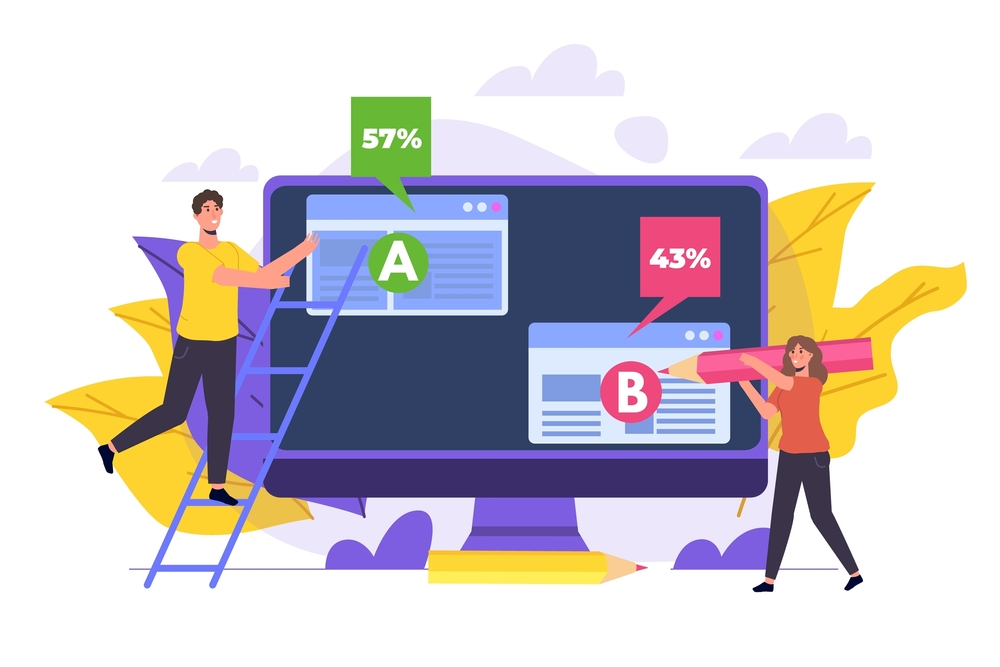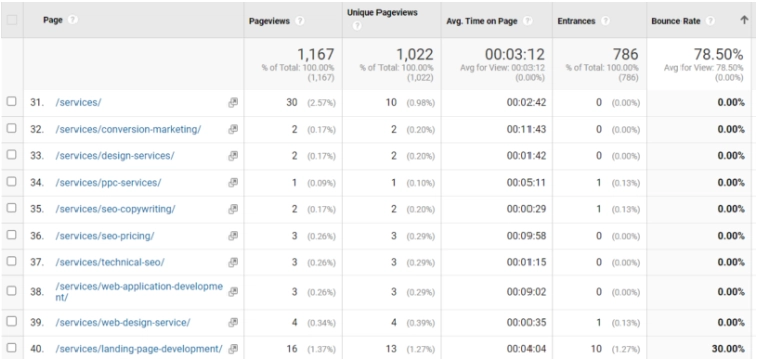This article highlights the Benefits of A/B Testing to those familiar with digital marketing and those just getting started. One key advantage of using websites as business marketing channels is their flexibility. For instance, when printing brochures, you can only quickly change headlines, text, colours or images by incurring significant printing costs – while on your website, changing anything costs practically nothing and can increase sales or conversions significantly!

What is the most effective way for your company website?
Digital marketers use A/B testing as a method for finding successful solutions. At the same time, this article highlights A/B testing’s benefits to those familiar with digital marketing and those just getting started in this arena.
What Is an A/B Test (also Known As Split Testing)
An A/B test, or split testing, is the practice of comparing two web versions (known as “A” and “B”) of a web page to assess which is superior.
Web tracking and modern web technology allow you to show visitors two versions of the same page simultaneously. Half of those who visit your website see version A, while the remaining half see version B; whichever proves more successful at converting visitors is considered the winner.
A/B testing is a key strategy in digital media marketing, commonly used for testing emails, web ads, website headlines/subheadlines/calls to action/crucial UI layout elements such as images or colour palettes etc. In this article, we highlight its advantages as a way of web optimization.
Digital marketers utilize A/B testing when they detect lower conversion rates, a decrease in potential customers during certain phases of sales funnels, high bounce rates or other conversion issues.
A/B testing is an economical and predictable method to identify the most effective strategy for optimizing your website over other promotion methods, such as focus groups or surveys. While A/B tests have drawbacks, let’s explore their benefits here.

What Are The Advantages of A/B Testing On Websites?
Businesses often ask, “Should I Spend My Money On A/B Testing? Our answer: Yes – it is less costly than losing customers and redesigning websites from scratch! Below we outline several advantages associated with A/B Testing to assist your business goals by increasing customer engagement through improved website designs.
Find ways to relieve visitors’ discomfort points.
People spend their time searching for and visiting websites to meet their desired goals. Whether learning more about a service/product offered, purchasing it, or seeking consultation services.
However, if visitors experience issues while browsing your site – such as confusing copy or an inaccessible CTA button. They’re likely to leave and not come back, meaning their issues won’t be solved. Your business won’t be part of a group that could help address them. This represents a loss for both parties involved.
A/B testing defines the ways to increase conversion rates
A/B testing is an effective strategy to increase conversion rates. Digital marketers can use A/B tests to monitor visitor conversion rates. Identify areas that need improvement, and determine which products may convert more effectively for customers than anticipated. A/B testing can help digital marketers learn what strategies work and which don’t – for instance. When an experienced copywriter creates two fantastic versions of an online product page copy – A/B testing can determine which version will convert customers more successfully.
Testing A/B offers an excellent opportunity to assess your existing copies of headlines, images and calls to action.

As can be seen from this data, it is apparent that “Make Your Money” drove greater conversions than “Save Your Funds”, yet by 2020 this had changed; people were looking for ways to save rather than generate funds.
If your conversion rates drop, try testing variations in marketing communications or calls to action. Market conditions change rapidly, so reviewing headlines and copy for websites and CTAs is wise.
A/B testing can reduce bounce rates
Goals were established in Google Analytics, yet high bounce rates without conversions remain. This indicates that your design, content or call-to-action only resonates with website customers, leading to them leaving. As for whether this has any significance? Well, the answer to that question is an overwhelming “Yes!” Check out more on the bounce rate’s significance within this article below.
A/B testing is an excellent way of discovering the most efficient solution to reduce the bounce rate on your business website pages. Changing advertisement words or call-to-actions, altering layout, or including extra details – A/B tests help determine what engages visitors more and help decrease bounce rates. Digitizer Sol Google Analytics report displays service pages with low bounce rates 0.

Noticing the distinctions between GA4 and Google Universal Analytics regarding “bounce rate” can help understand their definitions. With GA4, “bounce” refers to sessions on your website where visitors only visited one page with one request from your analytics server, while with GA4, it means the percentage of sessions that did not actively engage.
GA4 provides an easier method for measuring how often users interact with your website pages, although you should ensure data collection follows GA4’s model; its reports do not display Action, Category or Label categories.
Reducing the bounce rate is a primary goal when converting visitors into customers on your website.
A/B testing reduces risks and excludes the HiPPO effect
A/B testing reduces risks and eliminates the HiPPO effect. Website owners or digital marketers who wish to make significant modifications to their sites often wish for significant changes in designs, copywriting or branding that can bring positive outcomes; however, making such adjustments without proper testing may pose unnecessary risks and lead to negative consequences. A/B testing helps determine what changes produce positive outcomes versus those which bring about adverse results.
Utilizing A/B tests can also help mitigate the HiPPO effect. HiPPO stands for “Highest Paid Person’s Opinion.” Its name signifies its significance: when teams make decisions relating to website design, marketing strategy or brand identity, they give greater consideration to this individual due to biases such as experience and intuition that may cloud team members from making the best possible decision for business success. Using A/B tests helps eliminate unproductive decisions as they offer more data than intuition alone.
A/B tests can help you make more money
Over time, A/B tests help generate additional profits.
Business owners can save money by making sure that they make wiser choices when making design changes on websites, rewriting copy or altering images or altering calls-to-actions. A/B tests can assist in uncovering breakthrough ideas and making sound choices that will contribute to substantial profit growth.
However, A/B tests remain the most cost-effective way to validate digital marketing theories and collect valuable customer behaviour data.
How Can You Conduct A/B Testing
In this section, you’ll discover the essential elements of A/B Testing procedures.
Data Collection
Before making their optimization hypothesis a reality, marketing teams must collect information to establish issues and objectives. Data can help understand user behaviour when they interact with websites and pinpoint areas where potential customers have left the website altogether.
Modern web tracking tools such as Google Analytics provide invaluable data on website users’ locations, demographics, technologies and devices used by them and their behaviour on your site.
Digital marketers could utilize additional tools and methods such as heatmaps, surveys and interviews in marketing strategies.
Reviews from customers posted directly to your site or through third-party services like TrustPilot or Yelp are another invaluable data source.
Hypothesis Formulation
Once the marketing team has collected and analyzed data to identify areas where potential customers are abandoning a website, the next step should be identifying optimization options that offer a maximum return. They do this by translating each possibility into hypothesis form. Often this appears: If we implemented changes to this element, Y would rise by some amount.
Marketing teams should select hypotheses with the greatest chance of yielding positive outcomes while remaining cost-efficient.
Creating A and B variants and testing them
Subsequently, create A and B variations and analyze their results. Copywriters and designers can make pages with A and B variations that can be evaluated to assess performance.
Marketing departments should ensure that copywriters and designers receive specific assignments to avoid producing documents and layouts which don’t meet expectations. If they don’t, documents and layouts might have unexpected outcomes.
Once both versions have been developed, the marketing team may conduct the test. Most digital marketers utilize free Google Optimize or paid Google Optimize 360 for larger-scale projects. However, you may choose any A/B testing tool which suits your requirements. These tools typically allow users to create tests quickly.
Furthermore, these tools collect information and identify results that do not depend on random luck alone.
Analyzing Results
A/B testing tools allow marketers, business owners and others to monitor changes through reports that show the results of A/B tests. This way, marketing departments, business owners, and others can easily keep tabs on changes and make decisions accordingly.
Sometimes multiple tests will need to be run;
In others, you could discover solutions which boost efficiency by 100 or 500%. As mentioned in the previous paragraph, this information provides valuable knowledge about your customers without spending extra on market research.
If A/B testing produces positive results, you are free to select the most successful option.
Conclusions
Conclusions A/B testing takes the guesswork out of business and marketing decisions by providing data-backed answers for every decision arising from A/B tests, saving both time and cash for business owners and digital marketers.
Though A/B testing might appear straightforward, its inner workings contain hidden complexities that are difficult to navigate for beginners.
Therefore, seeking expert help with A/B testing would be prudent;
Additionally, hiring professional UI/UX designers increases your chance of having an effective website with high conversion rates for your company.




